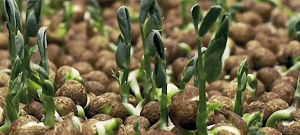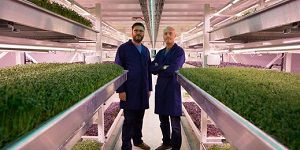The future of agriculture: How technology can help revolutionize how we feed the world
 We recently observed World Food Day, a day of action against hunger and the 70th anniversary of the United Nations’ Food and Agriculture Organization (FAO).
We recently observed World Food Day, a day of action against hunger and the 70th anniversary of the United Nations’ Food and Agriculture Organization (FAO).
While much progress has been made since the FAO’s formation, achieving global food security is no easy feat. In an industry dependent on environmental elements, things like the weather, water conditions, and natural disasters play a significant—and often unpredictable—role in agricultural productivity. With all these challenges, much remains to be done to eradicate hunger. According to the United States Secretary of Agriculture, it will take as much innovation in agriculture in the next 40 years as in the preceding 10,000 years to be able to feed the growing population.
When I think about what is needed in terms of innovation and agriculture management, I see tremendous opportunities to use today’s advancements in digital technology to help transform the agriculture industry. This includes providing new answers for things like irrigation and soil management, and enabling more intelligent, strategic uses of our resources to feed our growing world.
The catalyst for innovation in agriculture
Before I talk about some of these opportunities, it is important to provide a perspective of what is enabling them, and its significance.
Today’s connectivity (IoT) and rich data platforms offer a powerful force in their ability to turn pretty much “anything” into smart, connected “things”, and enable new insights into the big/small/complex/new/machine-generated data. A transformative example of this in the agriculture business is our work with Fujitsu, using connected devices on cows themselves to help farmers increase their production of milk and beef.
But connecting devices or things to IT systems is only the first step. What has changed goes beyond our ability to capture and collect data from them. What is propelling IoT and big data forward, along with the biggest potential for agriculture innovation, is cloud computing and important advancements in machine learning.
With the advent of unlimited storage and compute capacity in the cloud and advanced analytics capabilities, businesses now have the ability to combine their massive amounts of differing types of data together—from internal and external sources like data from the fields and weather forecasts—examine it in intelligent ways to identify patterns, and tell you how to solve a problem. And this can be done in real-time.
This is what’s creating opportunities that were unachievable until now, and that can enable exciting leaps forward in helping feed the world.
Enabling smarter agriculture
When these new technology capabilities are applied to the agriculture industry, we are now able to look at what’s going on and actually manage some of the exposure and vulnerabilities that we thought were inevitable from nature in a different way.
Microsoft researchers have found that advancements in machine learning provide more accuracy at predicting weather patterns in the next 24 hours than a traditional forecasting model. We believe this method could eventually be used to help us understand how climate change is affecting weather patterns or making more accurate long-term weather predictions. We can then match those weather patterns and data with production and crop data to optimize how we grow agricultural products. We can also analyze how our production reacts to humidity, rain, sunshine, drought and other variables. And from these we can now gain new insights into new efficiencies to be looked at.
We know that when it comes to food and agriculture, these are water- and energy-dependent industries. Are we now able to analyze irrigation and the impact of water and how to do this more efficiently, and get better results with less water? We are seeing early examples of that being possible, such as the work that Monterey Regional Water Pollution Control Agency (MRWPCA) is doing to utilize IoT to optimize the distribution of reclaimed water among farmers—and to help keep costs low by minimizing the energy involved.
Similarly, on energy, can we get better results with less energy, less electricity in the same environment or from the same investment? I believe that this is possible as well because of today’s digital innovations. Just look at Carnegie Mellon University. It is using Azure Machine Learning to track weather patterns and electricity usage in its buildings and has told Microsoft the system will enable them to save 30 percent on energy.
Feeding the future
 From large to small, to hyperlocal to global, we are seeing empowering examples of businesses that are beginning to harness the power of today’s technology innovations to create more intelligent ways to feed people everywhere.
From large to small, to hyperlocal to global, we are seeing empowering examples of businesses that are beginning to harness the power of today’s technology innovations to create more intelligent ways to feed people everywhere.
A British startup, Growing Underground, is sowing an agricultural revolution from 100 feet under the streets of London. It’s a fascinating look at what’s possible, transforming an old air raid tunnel into an energy and water-efficient environment to grow sustainable produce that can go from farm to table in only four hours. I encourage you to learn more about how they doing that with the help of Microsoft technology here.
On a larger scale, we’ve talked about how our partnership with Fujitsu is transforming lettuce production. Using IoT, machine learning, analytics and mobile technologies, Fujitsu was able to grow the perfect lettuce by making sure that greenhouse conditions were optimized using an unprecedented level of automation to manage precision, consistency and predictability.
And on a worldwide level, Syngenta is winning awards for its use of big data and advanced analytics to support global sustainability initiatives towards food production. It has developed a Water Intelligent Irrigation Platform that enables growers to remotely monitor and control their irrigation, combining water analytics with the actual delivery of water in precise amounts based on the data coming back to the system. In the United States, Syngenta is using Microsoft Azure to launch a content automation projectt to support its sales department and enhance data monitoring.
These are just a few examples of what is now possible with enormous potential for these methods to be used around the world. Today’s digital era is a truly exciting time to drive transformation through the power of digital technology, and these innovations will unlock agriculture’s potential to reduce hunger and feed the future of our world. Stay tuned.




